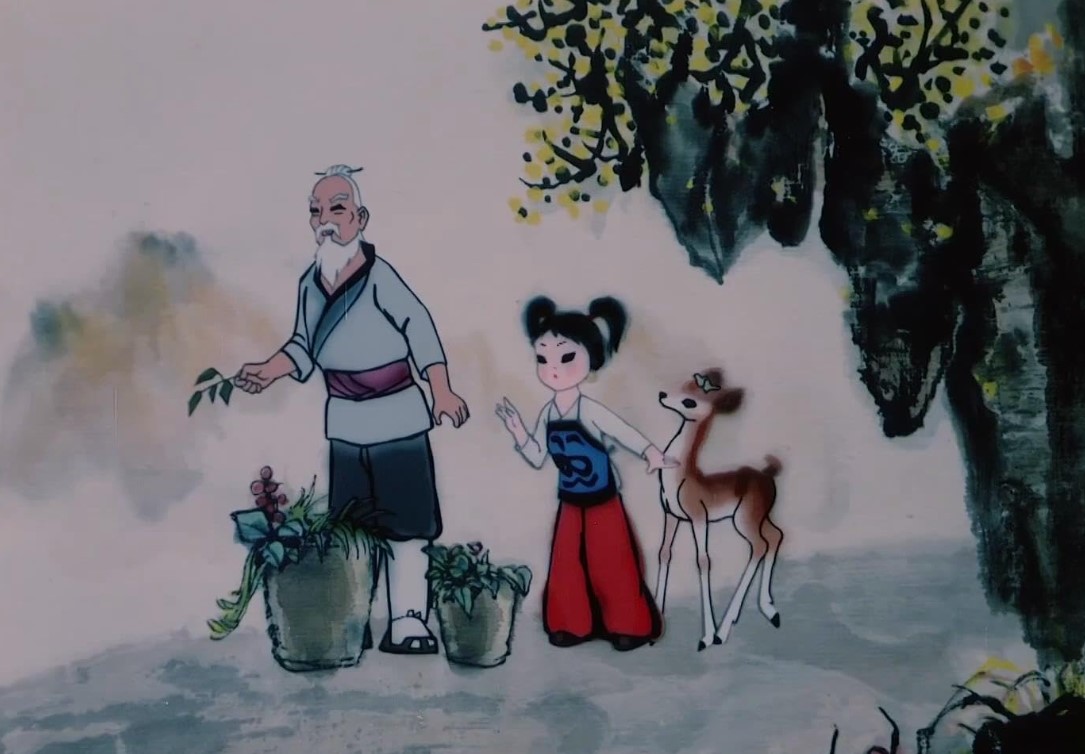BOOTLEG FILES 919: “The Deer’s Bell” (1982 Chinese animated short).
LAST SEEN: On YouTube.
AMERICAN HOME VIDEO: None.
REASON FOR BOOTLEG STATUS: It fell through the cracks.
CHANCES OF SEEING A COMMERCIAL DVD RELEASE: Maybe as part of a collection of Chinese animation.
One of the great joys of being a film writer is accidentally discovering a film that you never knew existed, then falling in love with it, and then being able to share that newfound love with anyone who will listen. I am now experiencing that sensation by sharing “The Deer’s Bell” with you via this column.
“The Deer’s Bell” is a 1982 short film produced by the Shanghai Animation Film Studio, and I freely admit that I know nothing about that organization or its output. The film was co-directed by Tang Cheng, who was China’s first female animation director, and Qiang Wu, and it was created in a style known as “shuimo animation” because it copied the look of the traditional Chinese ink and wash painting format known as “shuimo hua.” However, producing films in this style was time consuming and “The Deer’s Bell” is one of a handful of works that was created in this manner.
The eponymous deer is a fawn who lives in the forest with his loving mother and protective father. This family faces attack from an eagle that tries to seize the fawn and carry him away. The fawn’s parents fight off the avian intruder, but in panic the fawn runs into the woods and hurts one of its hind legs.
The injured animal is discovered by a little girl who is helping her grandfather gather herbs. The sympathetic child and her elderly guardian take the fawn home with them, but the animal’s parents are agitated when they cannot locate their offspring and search the forest for him.
The fawn is initially apprehensive about his new surroundings, but the girl wins over his confidence and she nurses him quickly back to health. The child and the young deer become inseparable and she takes him with her grandfather for a shopping trip in the local village. During that trip, the villagers find the fawn to be charming and adorable, although the young deer becomes confused when a monkey belonging to a street entertainer tries to ride its back.
One day, the girl injures her foot. By now, the fawn has matured to the point that he has begun to grow antlers. He is also domesticated in the manner of a well-trained dog, and he is entrusted with a bucket balanced on his antlers to go the village and pick up two pieces of fish from the local fishmonger, who knows and is entertained by the animal’s presence.
But the fawn’s new life is interrupted by the appearance of his parents, who never stopped looking for him. The challenge to the fawn is whether it should stay with his adoptive human family or reunite with his parents.
“The Deer’s Bell” is told without dialogue, with a music soundtrack consisting of traditional Chinese instruments used to emphasize the emotional aspects of its story. The absence of talk is a blessing – the story doesn’t require words to relay what is taking place or what is going through the characters’ thoughts. And the folk music aspect of the score transcends the confines of a calendar in presenting a tale that might seem historic based on costuming and setting but is also timeless in its appeal to the heart and mind.
I am unaware of this film ever being made commercially available for American audiences. The Wikipedia website claims Anchor Bay Films was a distributor, but I can’t confirm that – and, seriously, Wikipedia’s track record for accuracy is dismal. It has been presented on via the Yes Asia label, but that is a Hong Kong-based brand. If I am incorrect and “The Deer’s Bell” is commercially available on a US label, please share that information in the comments section below.
A not-entirely-pristine version of “The Deer’s Bell” is on YouTube in an unauthorized posting. And despite its decidedly non-high-definition upload, it is still one of the most sincerely beautiful stories ever presented via animation.
IMPORTANT NOTICE: While this weekly column acknowledges the presence of rare film and television productions through the so-called collector-to-collector market, this should not be seen as encouraging or condoning the unauthorized duplication and distribution of copyright-protected material, either through DVDs or Blu-ray discs or through postings on Internet video sites.
Listen to Phil Hall’s award-winning podcast “The Online Movie Show with Phil Hall” on SoundCloud and his radio show “Nutmeg Chatter” on WAPJ-FM in Torrington, Connecticut, with a new episode every Sunday. You can also follow his book reviews at The Epoch Times.

